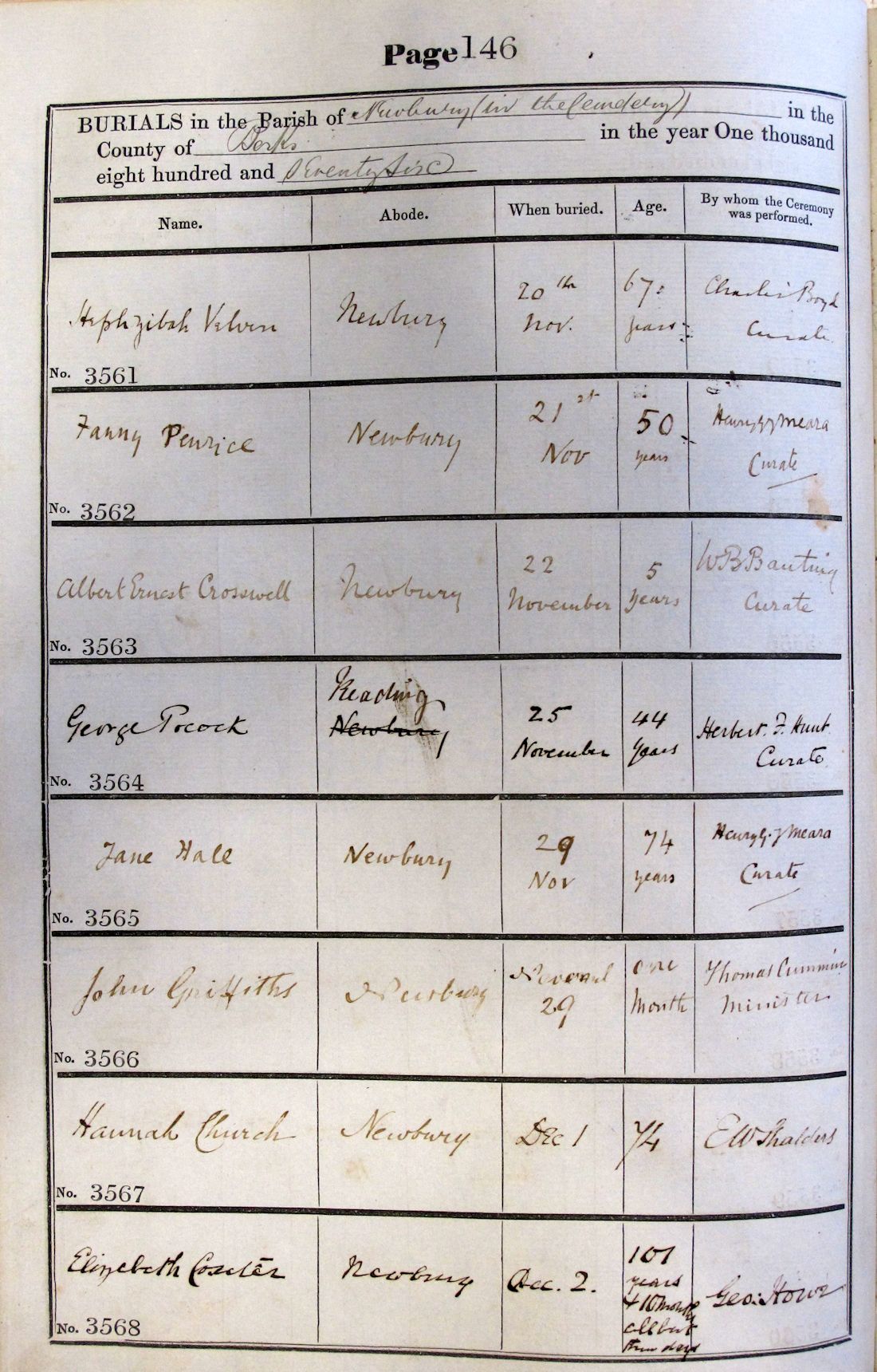
Personal Details of Elizabeth Coxeter
| Born: | |
| Died: | |
| Buried: | 02/12/1876 |
Listed below are all the details we have been able to find so far on Elizabeth Coxeter.
As far as we are aware, all the information is correct. However, sometimes transcriptions can lead to errors being made. If you find any errors or omissions, please let us know and we will endeavour to get them corrected as soon as possible.
If you have any further information on Elizabeth Coxeter, we would be delighted to hear from you.
Birth
There is no information in our database regarding the birth of Elizabeth Coxeter.
Can you help us? If so, please contact our History Research Group.
Death
There is no information in our database regarding the death of Elizabeth Coxeter.
Can you help us? If so, please contact our History Research Group.
Burial Register
| Name at death | Elizabeth Coxeter | ||||||
| Age at Death | 100 | ||||||
| Burial Date | 02 December 1876 | ||||||
| Abode |
Newbury |
||||||
| Official at Burial | George Howe | ||||||
| Comments | Age shown as "101 years + 10 months all but three days" | ||||||
| Burial Register Index |
|
||||||
| Sources | Burial Register |
Memorial Details
| From top of monument: In Memory of/ Elizabeth Coxeter/ Relict of John Coxeter/ Clothier of Greenham Mills/ died Nov. 27th. 1876/ aged 101 years& 9 months | |
| Name on Memorial | Elizabeth Coxeter |
| Date of death | 27/11/1876 |
| Age | 101 |
| Gender | Female |
| Memorial Type | Headstone and footstone |
| Construction Material | Sandstone |
| Condition of memorial | In laid letters; poor, many letters missing |
| Pattison Location Code | LS(H)34 |
Newspaper Cuttings
The articles below have been transcribed from newspapers and magezines.
Elizabeth Coxeter
| Source: | Newbury Weekly News | |||||||||
| Article date: | 30/11/1876 | |||||||||
| Copyright: | Newbury Weekly News | |||||||||
| Transciption: |
|
|||||||||
| This obituary entry is awaiting verification. | ||||||||||
A CENTENARIAN
| Source: | Newbury Weekly News and General Advertiser |
| Article date: | 04/02/1875 |
| Copyright: | |
| Transciption: | A CENTENARIAN. — On Monday last, February Ist, Mrs. Coxeter, of King John's Almshouses, attained the patriarchal age of one hundred years.
A large number of friends visited the venerable lady in the course of the day, and several presents were made her.
Mrs. Coxeter continues to enjoy good health, has possession of her faculties, and is able to get about. She is without doubt the oldest inhabitant of Newbury.
Thursday 04 February 1875 Newbury Weekly News and General Advertiser
|
| This obituary entry is awaiting verification. |
Pictures and photographs
The pictures below are all linked with Elizabeth Coxeter.
Click an image to show an enlarged version of it.
Elizabeth Coxeter
© D Collier

Mrs Coexeter
©
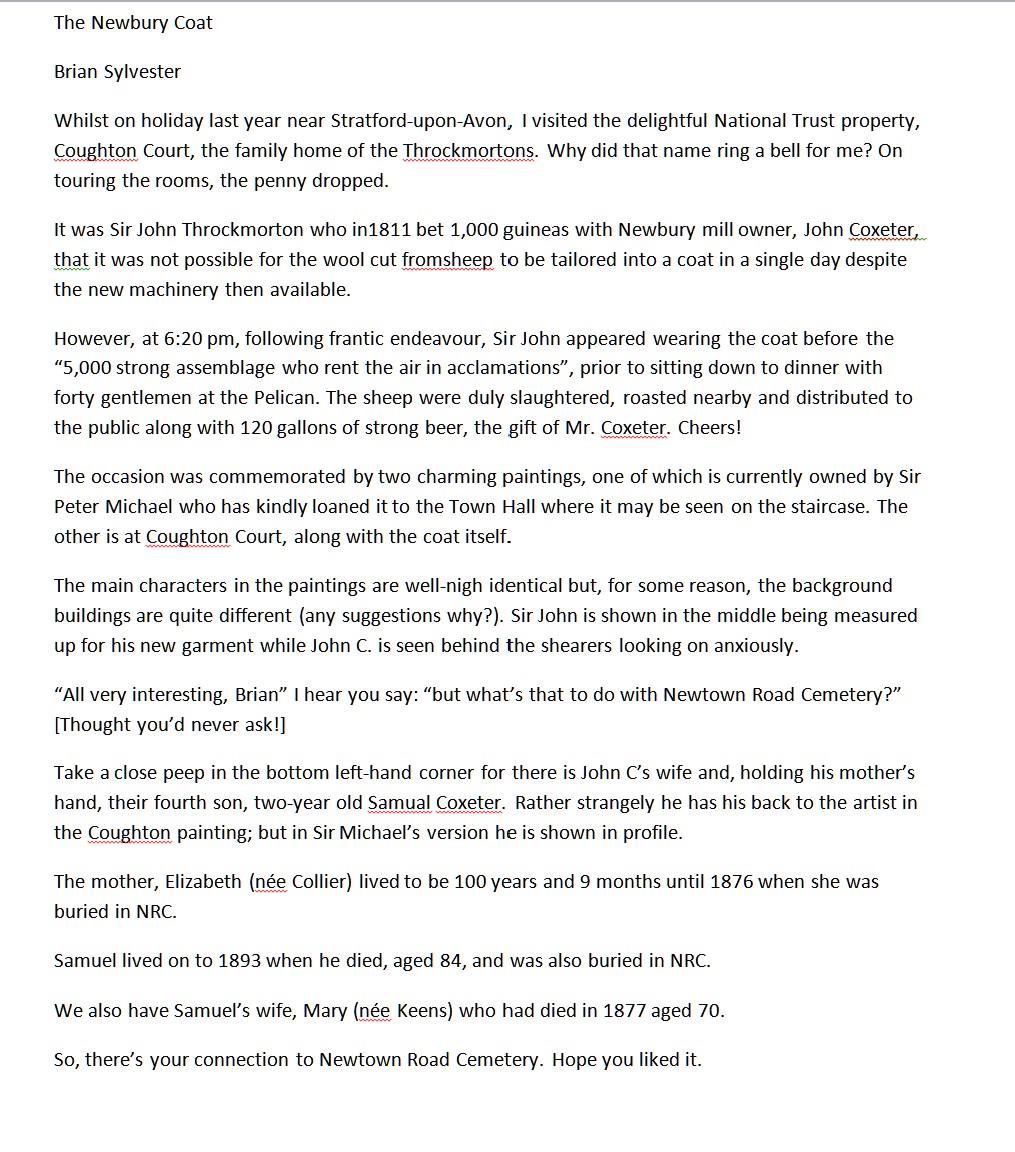
Newbury Coat (Throckmorton Coat)
©
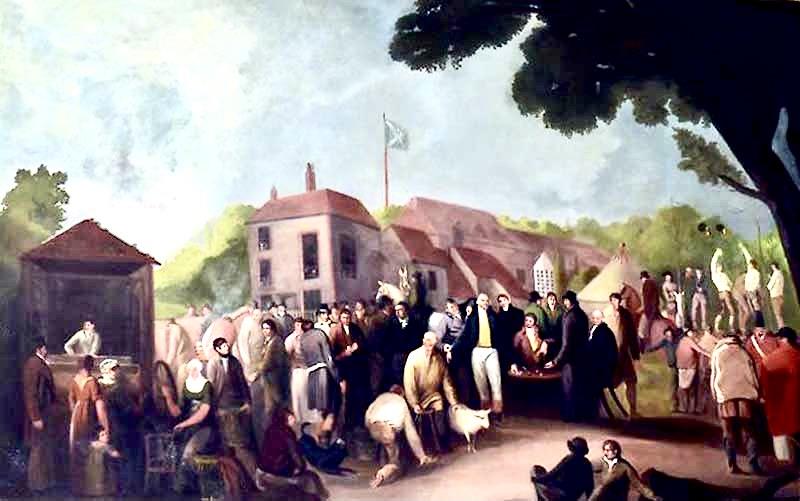
Throckmorton Coat
©
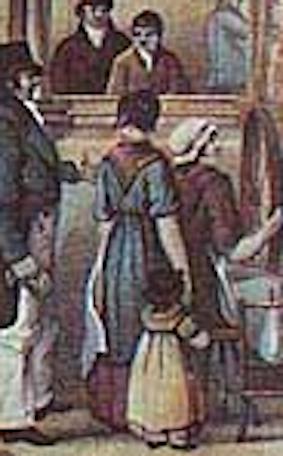
Throckmorton Coat 2
©
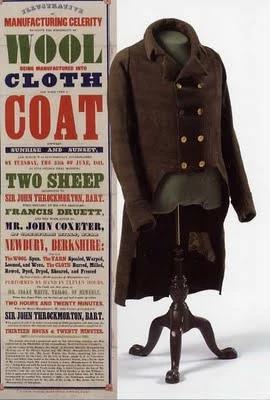
Throckmorton Coat 3
©
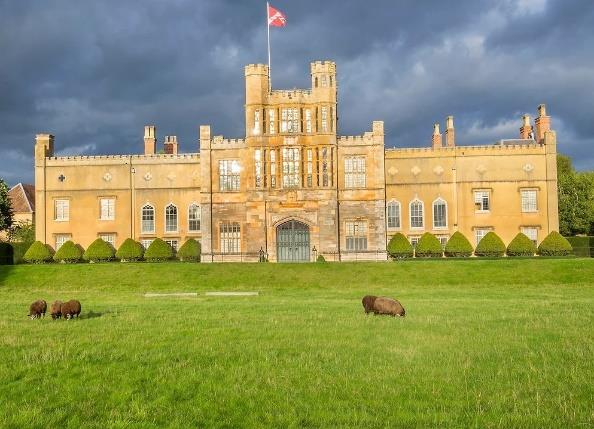
Coughton Court, the family home of the Throckmortons
©
Biographical Information
The articles below contain information about Elizabeth Coxeter.
John and Elizabeth Coxeter
John Coxeter Of Witney And Newbury
Husband of Elizabeth Collier; my 1st cousin 6 generations back.
Family research by © D. J. Collier of Midgham.
Mr. Jones.
John Coxeter Jun.
Elizabeth Coxeter and Samuel Coxeter.
William Coxeter.
Francis Druett.
Sir John Throckmorton.
Mr. Villebois.
Isaac White.
John Coxeter Sen.
The making of the Newbury Coat at Greenham Mill in 1811, painting by Mr. Luke Clint of Newbury.
The actual painting remained in the possession of Mrs Coxeter until her death in 1876 when it passed to her son Charles of Abingdon. In the centre of the picture is the shepherd, Francis Druett shearing one of the sheep; behind him is John Coxeter; on his left is Isaac White the tailor, measuring Sir John Throckmorton; on his left in black stands Mr. Villebois Esq. of Benham Park; and in front of him seated at the table is Anthony Bacon Esq.; to the right of John Coxeter stands John Locket a linen manufacturer of Donington; facing him and with his back towards us is Richard Dibley of Newbury, butcher; the youth besides him is John Coxeter, the son of John Coxeter; and the one with the basket of wool spools is William Coxeter. Both William and John are my second cousins five times removed. John is again represented working at the loom; the lady in front of him is his mother Elizabeth, with little Samuel Coxeter. The gentleman standing at the edge of the picture and behind Elizabeth Coxeter, is Mr Jones a cotton manufacturer of Greenham.
The coat was made for Sir John Throckmorton of Buckland House, Berkshire. (now in Oxfordshire).
From the information I have gathered; John son of Robert and Elizabeth Coxeter was baptised at Witney on the 29th July 1774. It also seems that after his father Robert died in 1788, he at the age of 14 was apprenticed to his uncle John Coxeter who died in February 1792. “Witney Blanket Company” records say that John was then turned over to James Marriott to serve out the rest his apprenticeship which would have ended in 1795. John would have been 18 in 1792, so his marriage that same year to Elizabeth Collier would have been a great relief to him; it would have guaranteed his long term prospects. Although John was a walking disaster when it came to business, he did make the Newbury Coat, a one off accolade woven on the day by his 17 year old son John, but with help from his 15 year old brother William. From what I have discovered, it looks as if John Coxeter may have taken full advantage of his wife’s family money. John and Elizabeth were married in St. Mary’s Church Witney on the 5th December 1792 when both were under age; Elizabeth 17, and John 18. The witnesses at their wedding were Samuel and Sarah Collier, Elizabeth’s elder brother and younger sister. After 1795 it looks as if John may have gone into partnership with Elizabeth’s brother Samuel, as a partnership between Samuel Collier and John Coxeter was dissolved in 1800. In 1805, Elizabeth’s father John, and brother Samuel came to his rescue when he went bankrupt while in partnership with a Richard Mason in Newbury; a partnership which may have been part funded by a £1,000 loan which John took out in 1802 from Edward Druce of Chigwell in Essex. A newspaper report of April 1805 stated that all persons indebted to the estate of John Coxeter late of Witney, are desired to pay their respective debts to Mr John Collier Sen. or Mr Samuel Collier the nominated assignees of his debts. This was followed later by a Witney Manor Court Roll of October which stated that John Coxeter had surrendered to John Collier a piece of Assart land (“forest land cleared of woods and brush”) which he held in Curbridge called “Quar Piece”; seemingly in part payment of his debts. This was eventually left to Elizabeth when her father died in 1819, and was still part of her personal estate in 1835.
Elizabeth Coxeter’s copy of her fathers Will which was used in 1835 as proof of her ownership of Quar Piece, Curbridge, Witney.
This document is in my possession.
After his bankruptcy in 1805, John Coxeter was again rescued by the Collier’s when he went into partnership with John Collier, Elizabeth’s younger brother. This appears to have saved him from losing Greenham Mill; however in February 1809 their partnership was dissolved, I assume after he had paid off his debts to the Collier family. While John Collier and John Coxeter may have ended their partnership it didn’t mean they didn’t work together. According to a “Holdens Directory” of 1811, both Coxeter and Collier were working as separate Blanket Manufacturers at Greenham Mill; while in the Berkshire volume of their Magna Britannica, published in 1813, the Lysons brothers referred to "a large and flourishing blanket manufactory" at Greenham Mills.
A page from the Greenham Mill ledger for 1811.
Not sure if it was for Coxeter or Collier.
Location: West Berkshire Museum
Ref: NEBYM:1980_185_1_1
Even after the success of the making of the Newbury Coat in 1811, John Coxeter was by 1816 a bankrupt again. This bankruptcy was according to Rex Coxeter of Essex, because he hadn’t been paid for hundreds of blankets which he had supplied to Russia. Why he was trading with Russia is a bit of a mystery as the Russian Government had banned all trade between the two countries. After maybe three failed partnerships and two bankruptcies, John died aged 42 in 1816, and was buried in Witney on the 28th August. The business at Greenham Mill was then taken over by his widow Elizabeth and her two sons; 23 year old John, and 21 year old William. This partnership which traded under the name of “E Coxeter and Sons”, blanket-manufacturer, was dissolved the following year 1817, when the leases and machinery at the Mill at Greenham had been sold. A newspaper advertisement listing what was for sale, gives a good impression of what it consisted of.
(By order of the assignees of the late Mr John Coxeter a Bankrupt)
By Mr R W Hiscock.
At the “Jack of Newbury” Inn, in Newbury unless disposed of by private contract, of which notice will be given.
THE LEASES OF GREENHAM FACTORY, comprising the complete woollen factory, late in the occupation of Mr John Coxeter, deceased, situate on the river Kennet, nearly adjoining Newbury, on leases for respective terms expiring at Lady Day 1885, Midsummer 1823, and Midsummer 1820; consisting of a modern and respectable Dwelling house, with excellent Gardens and Offices, Fulling Mill with convenient and extensive buildings for Carding and Spinning machinery; Weaving Shops, Warerooms, Bleaching Grounds and amply supplied with a fine and perpetual Stream of Water, equal to carrying on an extensive manufactory in the woollen or other trades requiring room and water; also having constant water carriage both to London and Bristol. The whole of the machinery in the worsted, cotton, blanket, and coarse cloth manufactory, may be taken at a fair valuation.
For a view, apply on the premises; and for further particulars (if by letter, post paid) to Mr Phipps, solicitor, Weavers Hall, Basinghall Street, London, where abstracts of the leases may be seen; Mr Bunny Solicitors, Newbury, where the original leases may be seen; or to Hiscock and Co. Surveyors, Stroud Green, Newbury.
The name of Mr Phipps the Solicitor at Weavers Hall is very interesting, as the Collier’s and Phipps’ were also related.
After the sale of Greenham Mill, the sons moved back to Witney, where by 1835 John was working, while William was working at Ducklington, both as blanket-makers. Elizabeth’s brother, John Collier, had stayed in Newbury for a while after 1809 as he was trading from Newbury in 1813. At sometime after this date he moved back to Witney where he would have continued to make his own blankets. Elizabeth it seems was left a poor widow as by 1841 she was living in number 10. St Bartholomew’s Almshouses Newbury, where she died in 1876.
Greenham Mill House, the home of John and Elizabeth Coxeter.
1791 Oxfordshire family History Wills
Left £600 by his uncle John Coxeter of Witney.
1792 Witney Blanket Company.
John Coxeter late apprentice to John Coxeter deceased, turned over to serve the remainder of his term with James Marriott.
1800
Samuel Collier and a John Coxeter dissolve their blanket making partnership in Witney.
Samuel, brother of Elizabeth Coxeter would have been 30, John Coxeter later of Newbury, aged 26. If it was John son of William Coxeter instead of John son of Robert, it could possibly tie in with a Samuel Collier of Witney who in 1816 kept his waggons at the Horseshoe Inn in Goswell St London. In 1812 this was the home of John Coxeter who was presumably the son of William and not Robert Coxeter.
1802 Oxfordshire Record Office
1. John Coxeter of Witney, blanket-weaver.
2. Edward Druce of Chigwell, Essex, gent.
1, is bound to 2, in £1000 to pay him £500 with interest
1805 The London Gazette
Whereas a Commission of Bankrupt is awarded and issued forth against John Coxeter, late of Witney, in the County of Oxford, and of Newbury, in the County of Berks, Blanket-Manufacturer, and he being declared a Bankrupt is hereby required to surrender himself to the Commissioners in the said Commission named or the major Part of them, on the 26th of February instant, on the 12th of March next, and on the 6th of April following, at Ten of the Clock in the Forenoon on each Day, at Guildhall, London, and make a full Discovery and Disclosure of his Estate and Effects; when and where the Creditors are to come prepared to prove their Debts, and at the Second Sitting to choose Assignees, and at the Last Sitting the said Bankrupt is required to finish his Examination, and the Creditors are to assent to or dissent from the Allowance of his Certificate. All Persons indebted to the said Bankrupt, or that have any of his Effects, are not to pay or deliver the same but to whom the Commissioners shall appoint, but give Notice to Mr. Mangnall, Warwick-Street, Newgate-Street, London.
1805 Gazette 6th April
John Coxeter of Witney and Newbury, Bankrupt. Blanket Manufacturer, Dealer and Chapman.
The firm of Coxeter and Mason
1805 Jacksons Oxford Journal April 20th
All persons indebted to the estate of John Coxeter late of Witney, are desired to pay their respective debts to Mr John Collier Sen. or Mr Samuel Collier, Assignees.
1805 Oxfordshire Record Office 25th October.
1. George, Duke of Marlborough. George Bulley, steward of Witney manor. 3. John Coxeter. 4. William Macey, attorney for 3. under Power of Attorney 21 Oct. 1805. 5. John Collier At the court of 1. held before 2, John Coxeter represented by 4 surrendered to John Collier subject to the rights of Edward Druce: Piece of land in Curbridge called Quar Piece, John Collier was admitted tenant.
1805 Gazette 21st May
Dissolved, the partnership of Coxeter and Mason, clothiers or cloth manufacturers at Greenham.
Signed by John Coxeter and Richard Mason, 27th April.
Richard could be Richard Mason, a 39 year old Mill owner and Clothier of Brookhouse, Painswick, Gloucestershire who died in 1806. In 1801 he was also a merchant at “Blackwell Hall”, the main wool trading establishment in Basinghall Street, London.
1809 Gazette, February. Dissolved Partnership.
THE Partnership heretofore subsisting between John Collier and John Coxeter, of Newbury, in the County of Berks, Blanket Manufacturers and Clothiers, was dissolved by mutual consent on the 21st instant: As witness our hands this 23rd Day of February 1809.
John Collier. John Coxeter.
This must have been John, brother of Elizabeth, John Coxeter’s brother in law.
1811 The Newbury Coat
The one outstanding success of John Coxeter’s life.
1813 Old Bailey proceedings.
John Collier Blanket-maker of Newbury, (Elizabeth Coxeter’s brother) named his blanket warehouse as, 26 Broad-Street-Place London.
It appears John Collier was still working in Newbury, even if he wasn’t working with John Coxeter at Greenham Mill. (A John Collier Blanket manufacturer died at Wash Common 1/8/1855).
1814 Walter Money history of Newbury.
Celebrations to honour the success of the British Army in the Peninsula and the prospect of peace with France.
At Greenham a monster pudding of 24 feet long was boiled and drawn on a timber-carriage by eight beautiful oxen, decorated with ribbons etc. to Mr. Coxeter’s manufactory, and served at a dinner given to 800 poor persons, at which Mr. Croft of Greenham Lodge presided.
1816
John Coxeter clothier of Newbury. Bankrupt.
1816 Witney Church Records
John Coxeter died and was buried at St Mary’s Witney.
1817 Gazette 12th June
Notice is hereby given that the partnership between Elizabeth Coxeter, Widow, John and William her sons of Greenham in the Parish of Thatcham, in the County of Berks. Blanket-manufacturers under the firm of “E. Coxeter and Sons”, has been dissolved by mutual consent.
Signed; Elizabeth Coxeter; John Coxeter; William Coxeter.
1817 The European Magazine and London Review; “Making the Newbury Coat in 1811”.
On the occasion, the two sheep were roasted whole on the day, 1 sheep and 120 gallons of strong beer given to the work-people belonging to the factory, the other to the public on board the “Prince Regent”, a vessel furnished for that purpose.
(This must have been a brand new vessel as the Prince was only made Regent on 5th February 1811. Although the barge may have belonged to John Coxeter, it could also have been a newly constructed barge, made by John Smith who had a barge building business at Greenham. Apparently five or six barges were built each year).
The “Prince Regent” may have been a barge belonging to John Coxeter, to take his blankets from Newbury to his warehouse in London. The original Kennet Navigation barges were 109 feet long by 17 foot wide. They weighed up to 128 gross tonnes, needed five men and a boy to crew them and between eight to twelve horses to pull them against the current of the rivers. I suspect though that it wasn’t one of these, but a smaller barge which carried around 60 tonnes, and needed only four men to crew them.
(I don’t know what tonnage the Prince Regent was, but if she was to carry blankets, I would imagine it must have been a large boat as the bales of blankets would have been relatively large compared to there weight. Newbury made barges were 70' by 14'' wide and carried around 50 to 60 tons).
Working Waterway. Newbury District Museum publication of 1995.
In 1760s the 1720 turf sided locks on the Kennet Navigation from Reading to Newbury were increased in size to take barges 122' by 19 feet wide. The West Country barges which had been used before the increased size, were the 109' by 17 feet wide, and carried 110 tones. They also had a sail which could be used on the Themes. In the 1800s a Newbury type of barge were being built at Greenham, and were around 70' by 14', carrying 50 tons. Locks are now around 80' by 13'6'', for barges carrying 60 tons. In 1840 K and A company preferred the use of smaller narrow boats of 6'11'' wide, carrying 35 tons.
Barge builders at Greenham were John Thomas Smith and Richard Horner. In 1830 John Smith was also a timber dealer. In 1815 there was a dock at Greenham, presumably a dry dock for building barges.
Berkshire Family History
The huge 'Newbury' barges 109ft (33m) long and 17ft (5.2m) in the beam and carrying 120 tons worked the Thames and the Kennet up as far as Newbury. They needed eight to 12 horses to haul against the river current and were worked by at least six men. K&ACC, rules defining the number of men to crew the 'fly boats' providing the five day through service with from Bristol to London. In 1844 the Company ruled that each barge or pair of boats working 'fly' (fast service with navigational priority) must be crewed by a captain and four men; also that each single boat must be crewed by a captain and three men.
The 60 ton Kennet Navigation barge “Unity”, launched circa 1885, a vessel that could have been very similar to the “Prince Regent”.
1820
John Collier, Elizabeth’s father died and left her the lease of the piece of land in Curbridge called Quar Piece, land that had been her husbands, John Coxeter. Elizabeth sold the lease in 1835.
A strange but uncanny fact is that 150 years after the making of the coat, I Derek Collier, worked in a house about two hundred yards from John Coxeter’s Mill House and Mill. The house I worked in was called Marsh House, and had belonged to John Haskins who owned a small Malt House situated just behind it. Could it be that it was Haskins’ beer that was drunk on the day as the Malt House was so close to Greenham Mill. If it wasn’t beer from his Malt House it could well have been from his son Henry’s brewery which was situated between the Market Place and the Wharf. As for Marsh House, I remember so well, having worked in it for around 17 years until it was demolished in the early 1980s. It was only in 2010 after researching the history of the house that I found out about the Haskins family and what they did. Now looking back at the written history of the making of the “Newbury Coat”, and knowing more about the spectacle of the day, I can easily connect the two families on that day. The Coxeter’s would certainly have visited the Haskins as they were next door neighbours, albeit on the other side of the river. So without knowing it, for seventeen or so years I must have been walking in the same steps of my own cousin, Elizabeth Coxeter.
Document about the making of the Newbury Coat.
A summary of the making of the Newbury Coat with the date, 25 June 1811, and time, 5am until 6.20pm. John Coxeter’s signed it by making a cross showing he couldn’t write, despite being a wealthy and successful manufacturer. It is written on an off cut of another document with writing on the back.
Coat made this Tuesday the twenty fifth day of June in the year of Our Lord One Thousand eight hundred and eleven. On the above mentioned day at five of the clock in the morning Sir John Throckmorton presented two Southdown sheep to Mr Coxeter of Greenham Mill near Newbury, Berkshire. The sheep were immediately shorn the wool sorted and spun the yarn spooled warped loomed and wove the cloth burred milled rowed dyed dried sheared and pressed. The cloth which was a hunting kersey of the admired dark Wellington color having been thus made in eleven hours was put in the hands of the tailors at four of the clock in the afternoon who completed the coat at twenty minutes past six. Mr Coxeter forethwith presents the coat to Sir John Throckmorton and trusts he will accept of some/same.
Witness. John Tanner. X one mark of Coxeter.
The Newbury Coat of 1811 and the bi-centenary 2011 Coat.
Timings for the 1811 coat challenge:
A transcript of the original document.
Shearing, carding and spinning of wool 1hr 5m
Winding, warping and looming 1hr 12m
Weaving nearly 3 ½ yds of the 7/4 cloth 1hr 45m
Burling 7m
Washing and milling 2hr 59m
Teazing 7m
Dying 1hr 5m
Drying, shearing and preping 2hr 40m
Making the coat 2hr 20m
TOTAL TIME 13hr 20m
-----------------------------
Extra Coxeter information.
Witney Blanket Company.
1792. January?
John Coxeter late apprentice to John Coxeter diseased, turned over to serve the remainder of his term with James Marriott.
1835 Oxfordshire Record Office
John Coxeter Blanket weaver in Witney
William Coxeter Blanket weaver in Ducklington
1854 Post Office Directory for Newbury
Miss Eliza Coxeter, day school, Bartholomew Street.
Ann Coxeter, mistress of girls school Railway Road.
Samuel Coxeter, Baker and pastry cook, 102 Northbrook Street.
William Coxeter, Tailor, Market Place.
Berkshire Record Office
Copy will of Charles Augustus Dore of Sudborough House, Northamptonshire, gent, 1815; probate of William Keens of Newbury, salesman, 1822; sale particulars, 1815 and 1893; and marriage articles (1838) and settlement (post nuptial, 1842) of Samuel Coxeter of Newbury, baker, and Mary Keens of Newbury, spinster The property conveyed in 1772 consisted of a single messuage in Northbrook Street bounded on the north by Northcroft Lane and on the west by a lane formerly called the Church Lane, leading to the Fountain; by 1807 this had been divided into two messuages, the southern being that later numbered 103. Property conveyed at various dates included the following:- A stable and loft on the south side of Northcroft Lane, 1807-1817, and a bakehouse erected on the same site, 1842; the messuage adjoining 103 Northbrook Street [and part of the original property], 1815-1842; four cottages at the back of the two messuages in Northbrook Street, 1822; messuages in Northcroft Street, Cheap Street and Bartholomew Street, 1822; and an allotment of land in Wash Common under the Wash Common inclosure, 1863. According to the depositor, this property is now 102 Northbrook Street.
Horseshoe Inn at number 7 Goswell St. in London.
1806 Old Bailey proceedings. Son of William Coxeter
John Coxeter, victualler, I live at the Horseshoe, Goswell St.
This was the Inn which Samuel Collier of Witney kept his waggons at until 1816. In 1851 it was still recorded as a Public House and Waggon Office.
A John Coxeter was in trouble in 1812, when as a Victualler, Dealer and Chapman (a trader) of Goswell Street London, he was made bankrupt, forcing him to sell his families weaving shop and premises near the bridge in Witney.
1812 Gazette Son of William Coxeter
John Coxeter. Bankrupt of Goswell St. London.
Victualler, Dealer and Chapman. (a merchant.) “Horse Shoe Inn”.
1812 Jacksons Oxford Journal 21st March Son of William Coxeter
To be sold by auction by Wm. Long on Friday 3rd Day of April 1812 between the hours of Five and Six o’clock in the afternoon at the White Hart Inn, Witney Oxen. (under the Commission of Bankrupt against John Coxeter of Goswell Street, London). All that FREEHOLD MESSUAGE or TENEMANT, roomy weaving shop and other convenient out-buildings, large garden with the appertances, situate near the bridge, in Witney aforesaid, now in the occupation of Thomas Slatter and others.
1805
Whereas a Commission of Bankrupt is awarded and issued forth against John Coxeter, late of Witney, in the County of Oxford, and of Newbury, in the County of Berks, Blanket-Manufacturer, and he being declared a Bankrupt is hereby required to surrender himself to the Commissioners in the said Commission named or the major Part of them, on the 26th of February instant, on the 12th of March next, and on the 6th of April following, at Ten of the Clock in the Forenoon on each Day, at Guildhall, London, and make a full Discovery and Disclosure of his Estate and Effects; when and where the Creditors are to come prepared to prove their Debts, and at the Second Sitting to choose Assignees, and at the Last Sitting the said Bankrupt is required to finish his Examination, and the Creditors are to assent to or dissent from the Allowance of his Certificate. All Persons indebted to the said Bankrupt, or that have .any of his Effects, are not to pay or deliver the same but to whom the Commissioners shall appoint, but give Notice to Mr. Mangnall, Warwick-Street, Newgate-Street, London.
Author: D Collier
© various sources
*The FNRC believe that the certificates published on this page have been added in compliance with the rules laid down by the General Register Office (GRO). Click here for more information.
If you believe that we may have inadvertently breached the privacy of a living person by publishing any document, please contact us so we can immediately remove the certificate and investigate further.
Thank you.
FNRC.
© 2010-2023. Friends of Newtown Road Cemetery, unless otherwise stated.
Web site designed by Paul Thompson
The Friends of Newtown Road Cemetery is a not-for-profit organisation that works in association with Newbury Town Council to look after and maintain Newtown Road Cemetery for the benefit of the people of Newbury.
